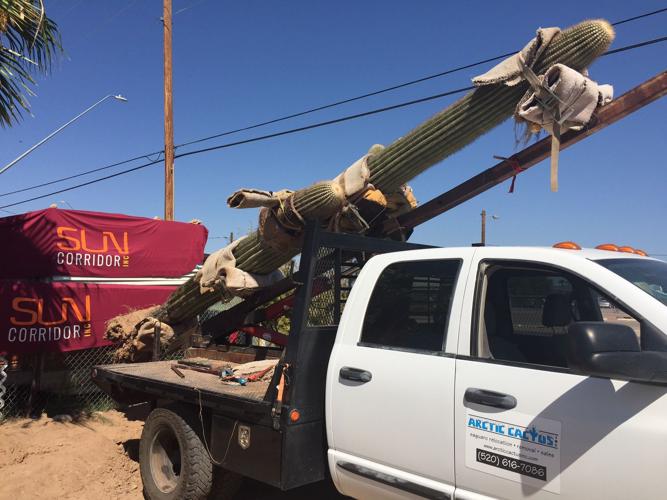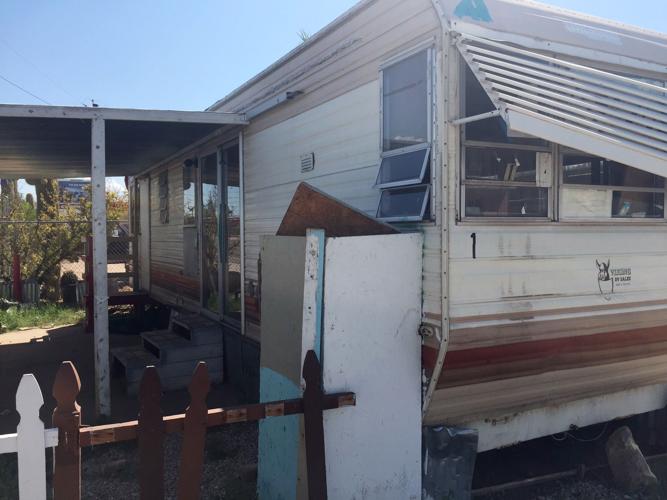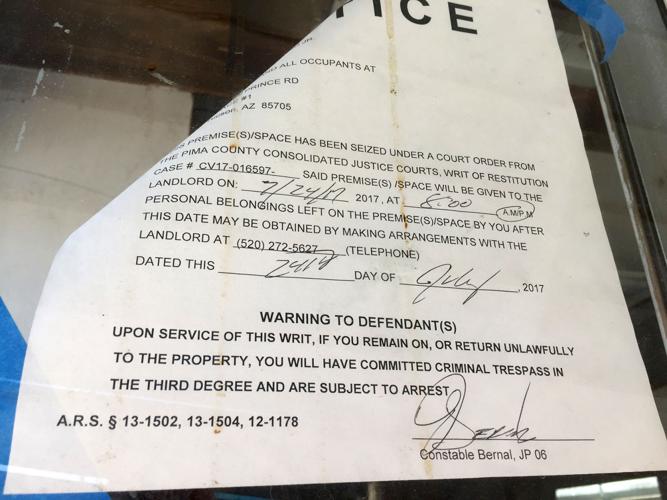The symbol of Tucson that local officials wanted Jeff Bezos to see was right there before us at a press conference Wednesday.
It was a striking Southern Arizona saguaro, 21 feet tall, destined for Seattle in an effort to catch the Amazon CEO’s attention and make him want to put the company’s new headquarters here.
But behind the saguaro, covered in banners with the name of Sun Corridor Inc., was another symbol of Tucson. It’s not one that anyone wants the outside world to see, but it represents today’s Tucson pretty accurately.
The signs for Sun Corridor, the Tucson area’s economic development group, hung on the end of a battered, abandoned trailer, which sits at the front of the Flamingo Palms Mobile Home Park on West Prince Road. The trailer has a July 24 eviction notice posted on its other end.
It’s normal for there to be a contrast between what we aspire to and what we are — a metro area with a 19 percent poverty rate that ranks us among the poorest cities. And yet, the inevitability of there being an old abandoned trailer behind the set of our sales pitch to Amazon made me think: We’re really overreaching when we try to land this deal.
The Amazon headquarters project, dubbed HQ2 because it will be the company’s second central office after the one in Seattle, is the country’s biggest economic development prize in decades, as Joe Snell, the CEO of Sun Corridor, pointed out Wednesday. Over 15 years, as many as 50,000 people will work there at salaries averaging more than $100,000, the company says.
It will likely transform the economy of whatever city it lands in. No wonder Snell and Tucson Electric Power CEO David Hutchens, who is chair of Sun Corridor’s board, could not resist pursuing it.
But of course Amazon has criteria for cities wanting to land HQ2, and we barely meet them, if we do at all. For one, the metropolitan population is supposed to be at least 1 million, and according to the University of Arizona, Tucson’s was 1,013,103 at the end of 2016.
For another, Amazon refers to wanting to locate in a “stable business climate for growth and innovation.” The New York Times, which analyzed Amazon’s criteria and came up with a likely winner — Denver — eliminated Tucson and a couple of other dozen cities because of our weak job growth. The article singled out Tucson and Birmingham, Alabama, as actually having lost jobs over the last decade.
Among our other flaws, we do not have two regular flights that Amazon demands — nonstops to New York and Washington, D.C. We can’t even argue that we might sustain such flights if given the opportunity, because we have had both in recent years and lost them due to insufficient business. We also don’t have much of a mass transit system as required by Amazon.
This isn’t to say Tucson is a bad place or an impossible choice for Amazon. It’s just to say Amazon is out of our league — we’re in Triple A and the real contenders are in the majors.
Economic development officials have repeatedly noted that we impressed the Tesla site selectors when they were looking to find a home for the “gigafactory” that they ultimately placed near Reno. But the Tesla project had criteria that Tucson actually met, including large tracts of land, ample sun for solar power, and proximity to key transportation corridors.
For Amazon, we have land, yes, we have a good cluster of logistics businesses, we have a strong university from which the company could draw talent. Good weather. Great mountains. And yes, we have saguaros.
On Thursday, the saguaro that is supposed to go to Seattle was still sitting at the site of the Arctic Cactus nursery where the press conference was held. Paperwork is being processed for the saguaro’s travels, Sun Corridor spokeswoman Laura Shaw told me. For the sake of that saguaro, we should hope the whole trip falls through. It won’t survive outdoors in Washington state, of course, nor would it likely survive in the indoor terraria that Amazon built in downtown Seattle.
It’s a creative publicity stunt, sure. But it can’t cover up our shortcomings — the same way those banners couldn’t cover up the abandoned trailer.
Stegeman votes no again
A couple of weeks ago I called out TUSD board member Mark Stegeman for repeatedly finding reasons to vote “no,” on the hiring of or contracts for superintendents.
In August, Stegeman voted against the selection of Gabriel Trujillo as permanent superintendent because a contract had not been finalized yet.
“I disagree with the practice of naming a superintendent or any other administrative position before contract terms have been agreed,” Stegeman said at that meeting. “I’ll be voting no for that reason. It would not matter what the name was.”
Of course, Stegeman made no secret of the fact that he preferred former C.E. Rose K-8 principal Stephen Trejo as a candidate. His colleagues disagreed.
On Tuesday, Stegeman got the chance to show that the contract issue was the real reason for his earlier no vote. The board agreed in executive session to contract terms with Trujillo and simply needed to publicly approve the new contract. Once again, Stegeman voted no.
“I will support the decision of the board,” was Stegeman’s only comment at the meeting.
Apparently, the contract was not the real issue.
Disguise: Tuition lawsuit
Last week, Arizona Attorney General Mark Brnovich was facing the prospect of a political loser. He had to either sue the Arizona Board of Regents himself, because they’ve been offering in-state tuition to DACA recipients, or accept that an outside party would do it and charge Arizona exorbitant legal fees.
He chose the only realistic course, which was to sue the regents, because they are obviously breaking the law — mind you, a law that is cruel and self-defeating for Arizona. The 2006 voter-approved law requires that no one who is in the country illegally receive benefits like in-state tuition. Sadly, it is not ambiguous.
But then Brnovich had a flash of genius! He would go ahead and sue over in-state tuition. But he would also sue the regents because they have not adhered to the state constitutional requirement that tuition at the state universities be “as nearly free as possible.”
The issues are linked, of course, in that they both deal with the cost of education at the state’s universities. But they are also linked in this way: One, the DACA suit, is politically harmful to Brnovich while the other, the tuition suit, is politically beneficial. It’s not surprising he filed them on the same day.
Giffords endorses in CD2
Former Rep. Gabrielle Giffords’ endorsement was perhaps the most prized among Congressional District 2 Democrats seeking to challenge Rep. Martha McSally. Now that Ann Kirkpatrick has it, a race is firmly in place between candidates representing the party’s two establishment branches.
On the left is Mary Matiella, who is endorsed by Rep. Raúl Grijalva and supported by Bill Roe, a longtime Dem fundraiser who is vice chair of the state party.
On the right, now, is Kirkpatrick. The former congresswoman from Flagstaff has the support of both Giffords and her successor, former Rep. Ron Barber.







